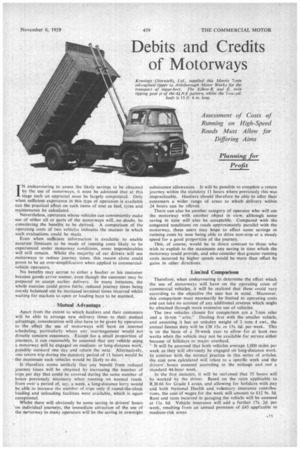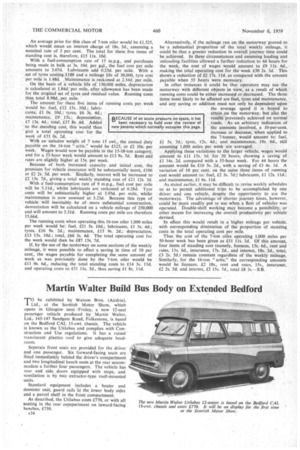Debits and Credits of Motorways
Page 75

Page 76

If you've noticed an error in this article please click here to report it so we can fix it.
Assessment of Costs of Running on High-Speed Roads Must Allow for Differing Aims
Planning for Profit
IN endeavouring to assess the likely savings to be obtained by the use of motorways, it must be admitted that at this
stage such an appraisal must be largely conjectural. Only when sufficient experience in this type of operation is available can the practical effect on such items of Cost as fuel, tyres and maintenance be calculated.
Nevertheless, operators whose vehicles can conveniently make use of either all or parts of the motorways will, no doubt,be considering the benefits to be derived. A comparison of the operating costs of two vehicles indicates the manner in which -such evaluations could be made.
Even when sufficient information is available to enable accurate forecasts to be made of running costs likely to be experienced under motorway conditions. some imponderables will still remain. Whilst the majority of car drivers will use motorways to reduce journey times, this reason alone could prove to be an over-simplification when applied to commercial. vehicle operators, No benefits may accrue to either a haulier or his custother because goods arrive sooner, even though the customer may he prepared to accept earlier delivery. In many instances, the whole exercise could prove futile, reduced journey times being merely balanced out by increased terminal times incurred whilst waiting for markets to open or loading bays to be manned.
Mutual Advantage .
Apart from the extent to which hauliers and their customerswill be able to arrange new delivery times to their mutual. advantage, consideration will also have to be givenby operators to the effect the use of motorways will have on internal scheduling, particularly Where any rearrangement would not directly concern customers. -Except for a small proportion of journeys, it can reasonably be assumed that any vehicle using a motorway will be engaged on mediumor long-distance work, possibly outward one day and return the next. Alternatively, one return trip during the statutory period of 11 hours would be
• the maximum such vehicles would be likely to do.
It therefore seems unlikely •that any benefit from reduced journey times will be obtained by increasing the number of trips per day that could be covered during the same number of hours previously necessary when running on normal roads. Even over a period of, say, a week, a long-distance lorry would be able to increase the number of trips only if round-the-clock loading and unloading facilities were available, which is again exceptional.
Whilst there will obviously be some saving in drivers' hours on individual journeys, the immediate attraction of the use of the motorway to many operators will be the saving in overnight subsistence allowances, it will be possible to complete a return journey within the statutory II hours where previously this was impracticable. Hauliers should therefore be able to offer their customers a wider range of areas to which delivery within .24 hours can he offered.
There can also be another category of Operator who will use the motorway with another object in view, although some saving in time will also be acceptable. Compared with the congested conditions on roads approximately parallel with the motorway, these users may hope to effect some savings in running costs by now being able to drive non-stop, at a steady speed for a good proportion of the journey.
This, of course, would be in direct contrast to those who wish to exploit to the maximum any saving in time which the motorway could provide, and who consider that greater running costs incurred by higher speeds would be more than offset by gains in other directions.
Limited Comparison
Therefore, when endeavouring to determine the effect which the use of motorways will have on the operating costs of commercial vehicles,, it will be realized that these could vary according to the objective the user hasin mind. Moreover, this comparison must necessarily be limited to operating costs and can take no account of any additional revenue which might be obtained through more extensive use of vehicles.
The two vehicles chosen for comparison are a 7-ton oiler and a 16-ton artic." Dealing first with the smaller vehicle, and assuming it has an unladen weight of 3 tons 4 cwt., the annual licence duty will be £38 15s. or I5s. 6d. per week. This is on the basis of a 50-week year to allow for at least two weeks when the vehicle may not be available for service either because of holidays or 'major overhaul.
It will be assumed that bothvehicles average 1,000 miles per week as they will obviously be engaged on long-distance work. In contrast with the normal Practice in this.series of articles, the cost now calculated will relate to a specific week and the drivers' hours assessed according to the mileage and not a standard 44-hour week.
In the first instance; it will he reckoned that 55 hours will be worked by the driver. Based on the rates applicable to R.1-1.66 for Grade I areas, and allowing for holidays with pay and both National Health and voluntary insurance contributions, the cost of wages for the week will amount to £12 9s. 5d. Rent and rates incurred in garaging the vehicle will be assessed at I is. 6d. Vehicle insurance will add a further 178. 2d. per week, resulting from an annual premium of £43 applicable to medium-risk areas.
An average price for this class of 7-ton oiler would be £1,525, which would mean an interest charge of 18s. 3d., assuming a nominal rate of 3 per cent. The total for these five items of standing cost is, therefore, £15 I Is. 10d.
With a fuel-consumption rate of 15 m.p.g., and purchases being made in bulk at 3s. 10d, per gal., the fuel cost per mile amounts to 3.07d. Lubricants add 0.25d. per mile. With a .set of tyres costing £188 and a mileage life of 30,000, tyre cost per mile is 1.48d. ,Maintenance is .reckoned at 2.34d. per mile.
• On the basis of a vehicle life of 150,000 miles, depreciation is calculated at 1.84d: per mile, after allowance has been made • for the original set of tyres and residual value. Running costs • thin total 8.98d_per mile.
The amount for these five items of would be: fuel, £12 15s. 10d.; lubricants, £1 Os. 10d.; tyres, £6 3s. 4d.; maintenance, £9 15s.; depreciation, £7 13s. 4d.; total, £37 8s. 4d. Added to the standing cost, this would then give a total operating cost for the week of £53, Os. 2d.
With an unladen weight of 7 tons 15 cwt., the annual duty payable on the 16-ton "attic." would be £125, or £2 10s. per week. Wages would now be payable in the 15-18-ton category, and for a 55-hour week would amount to £13 9s. 7d. Rent and rates are slightly higher at 15s. per week.
Because of both increased capacity and initial cost, the premium for vehicle insurance will be substantially more, £106 or £2 2s. 5d. per week. Similarly, interest will be increased to £2 15s. 7d., giving a total weekly standing cost of £21 12s. 3d.
With a.-• fuel-consumption rate of 9 m.p.g., fuel cost per mile will be '5.11d.; whilst lubricants are reckoned at 0.28d. Tyre costs will be' substantially higher at 3.95d. per mile, whilst maintenance is now assessed at 3.2Id. Because this type of vehicle will inevitably, be of more substantial construction, deoreciation will be calculated on a vehicle mileage of 250,000 and will amount to 3.31d. Running costs per mile are therefore 15.66d.
The running costs when operating this 16-ton oiler 1,000 miles per week would be: fuel, £21 5s. 10d.; lubricants, £1 3s. 4d.; tyres, £16 9s. 2d.; maintenance, £13 9s. 2d.; depreciation, £13 15s. 10d.; total, £66 3s. 4d. The total operating cost for the week would then be £87 15s. 7d.
If, by the use of the motorway on some sections of the weekly mileage, it were possible to effect a saving in time of 10 per cent., the wages payable for completing the same amount of work as was previously done by the 7-ton, oiler would be £11 Os. 6d., reducing the total standing costs to £14 3s. lid. and operating costs to £51 I Is. 3d., thus saving £1 8s. 11d. running costs per Week
BECAUSE of an acute p been necessary to hol new patents which norma
Alternatively, if the mileage run on the motorway proved to be a substantial proportion of the total weekly mileage, it could be that a greater reduction in overall journey time could be achieved. In these circumstances and assuming loading and unloading facilities allowed a further reduction to 44 hours for the week, the cost of wages would amount to £9 I Is. 6d., making the total operating cost for the week £50 2s. 3d. This shows a reduction of £2 17s. 11d, as compared with the amount payable when 55 hours were necessary.
In other instances it could be that operators may use the motorway with different objects in view, as a result of which running costs could be either increased or decreased. The three items most likely to be affected are fuel, tyres and maintenance, and any saving or addition must not only be dependent upon the average speed it is hoped to attain on the motorway, but also the results previously achieved on normal roads. As an arbitrary indication of the amounts involved, a 10-per-cent. increase or decrease, when applied to the 7-tonner, would amount to: fuel, £1 5s. 7d.; tyres, 12s. 4d.; and maintenance, 19s. 6d., still assuming 1,000 miles per week are averaged.
Applying these variations to the larger vehicle, wages would amount to £11 15s. Id. for 50 hours, showing a saving of LI 14s. 2d. compared with a 55-hour week. For 44 hours the amount would be £10 5s. 2d., with a saving of £3 4s. Id. A variation of 10 per cent. on the same three items of running cost would amount to: fuel, £2 3s. 7d.7 lubricants, £1 12s. lid.; and maintenance, £1 6s. 11d.
As stated earlier, it may be difficult to revise weekly schedules so as to permit additional trips to be accomplished by one driver and one vehicle, despite the opportunity to U3C the motorways. The advantage of shorter journey times, however, could be more readily put to use when a fleet of vehicles was operated. Double-shift working may become a possibility, or other, means for increasing the overall productivity per vehicle devised.
In effect this would result in a higher mileage per vehicle, with corresponding diminution of the proportion of standing costs in the total operating cost per mile.
Thus the cost of the 7-ton oile; operating 1,000 miles per 50-hour week has been given as £51 I ts. 3d. Of this amount, four items of standing cost (namely, licences, 15s. 6d., rent and rates, I is. 6d., insurance, 17s. 2d., and interest, 18s. 3d., total, £3 2s. 5d.) remain constant regardless of the weekly mileage. Similarly, for the 16-ton " artic," the corresponding amounts would be licences, £2 10s., rent and rates. 15s., insurance, £2 2s. 5d. and interest, £2 15s. 7d., total £8 3s.-S.B.
ressure on space, it has d over the review of Ily occupies this page.












































































































